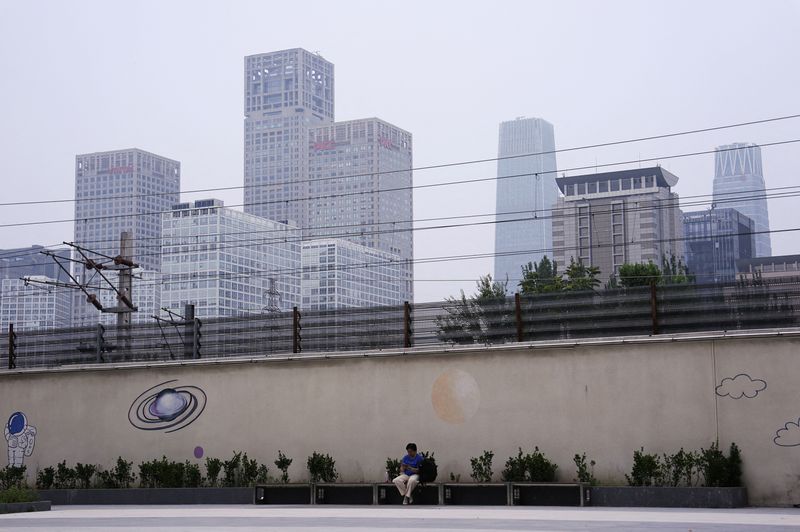By Kevin Yao
BEIJING (Reuters) – Chinese government advisers have recommended that Beijing maintain its economic growth target of around 5.0% for next year, pushing for stronger fiscal stimulus to cushion the impact of expected U.S. tariff increases on the country’s exports.
Ambitions to sustain the seemingly elusive growth rate throughout 2024, if confirmed, would surprise financial markets with bets on a slowdown in the world’s second-largest economy as trade tensions escalate.
Four out of six advisers who spoke to Reuters favored a 2025 target of around 5%. One adviser suggested a target of “more than 4%” and another suggested a range of 4.5-5%. A Reuters poll this week predicted China would grow 4.5% next year, but also said tariffs could slow growth by 1 percentage point.
The advisers, who are not involved in decision-making, will submit their proposals to the annual Central Economic Working Conference that closes next month, when top leaders discuss policies and goals for the coming year.
The target, one of the most watched indicators globally for clues about Beijing’s short-term policy goals, will not be officially announced until the annual parliamentary meeting in March.
Recommendations from advisors are considered by policy makers in the final decision making process. The most popular view among advisors is usually adopted although this is not always the case. Any plans are still subject to change before the legislative session.
Most of the advisers commented on the condition of anonymity because they are not authorized to speak to the media.
Holding high growth goals in the face of threatened tariffs, more than 60% in imports of Chinese goods from the entry of US President Donald Trump suggests that Beijing is ready to spend big, especially if it can not negotiate a lower levy or delay people.
“You can offset the impact of Trump’s tariffs on China’s exports by increasing domestic demand,” said Yu Yongding, one of the government’s advisers and economists who supports the roughly 5% target.
“We need to implement a stronger fiscal policy next year,” Yu said, adding that the budget deficit “will definitely have to exceed” this year’s planned level of 3% of gross domestic product (GDP).
Some economists have called for Beijing to scrap or adopt lower growth targets to reduce reliance on stimulus, which has fueled a property bubble and massive local government debt. But supporters of the ambitious target say it is essential to maintaining China’s global standing, national security, and social stability.
President Xi Jinping’s vision of “Chinese-style modernization” envisions doubling the size of the economy by 2035 from 2020 levels, potentially surpassing the United States. Economists outside of China do not believe these goals are realistic, but they still influence domestic policy discussions.
“To achieve the 2035 goal, we need to achieve economic growth of around 5% by 2025,” said a second government adviser.
It is not known how many such proposals the government has received.
EXPORTS ARE VULNERABLE
International Monetary Fund Managing Director Kristalina Georgieva warned last month that China’s growth could slow to “below 4%” unless it changes from an export-led economic model and investment driven by consumer demand.
The threat of tariffs has rattled China’s industrial complex, which sells more than $400 billion worth of goods a year to the United States. Many manufacturers have shifted production overseas to escape tariffs.
Yu downplayed Trump’s threat, pointing out that China’s net export GDP contribution is small. They account for 2.2% of GDP in 2023 even though gross exports account for almost 20% of total economic output, official data show.
Other economists say industrial output, profits, investment and jobs are too dependent on external demand and additional trade barriers could increase deflationary pressures and headwinds.
“If China’s exports are hit and cannot be offset by rising domestic demand, deflationary pressures will intensify,” said an adviser who suggested a target of “more than 4%.”
Advisers who proposed 4.5-5% said: “Economic pressure will be greater next year. Our exports could be greatly affected.”
Another stimulus?
This month, China unveiled a 10 trillion yuan ($1.4 trillion) debt package to ease municipal financing strains, but ruled out immediate fiscal stimulus. Analysts say Beijing may want to keep the powder dry until Trump makes the first move.
Finance Minister Lan Foan said more stimulus measures were in the pipeline, without elaborating on their size or timing.
Government advisers said China’s budget deficit could rise to 3.5-4% of GDP next year and that other special treasury bonds, usually not included in the annual budget, could be issued to finance infrastructure and other investments.
He said a consumer-focused policy could include stronger financial support for low-income residents and expanding a subsidy scheme launched this year to boost purchases of appliances, cars and other goods. Handover of large-scale cash vouchers is unlikely, the adviser said.

But he also urged officials to move forward with tax, welfare and other policy changes to address structural imbalances.
“If reforms stop and we rely only on policy stimulus, it will not be sustainable in the long term,” said the most conservative adviser.




